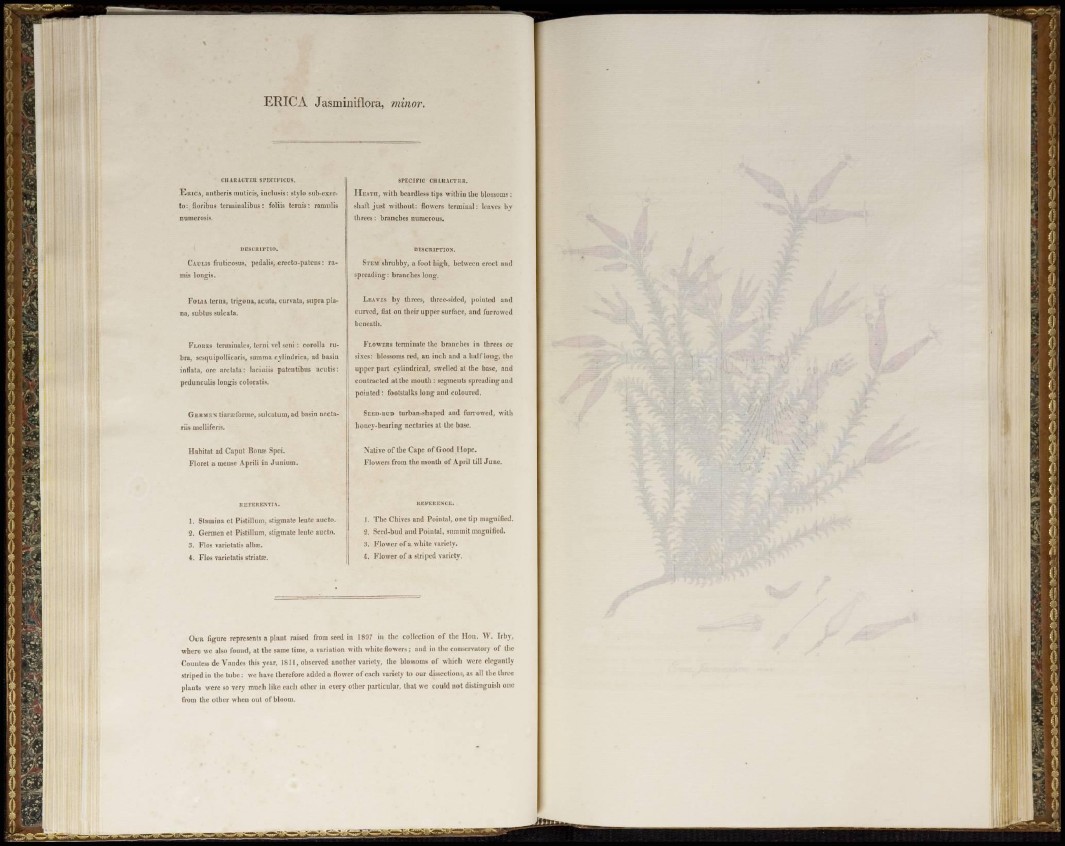
ERICA Jasminiflora, minor.
CHARACTER SPECIF1CUS.
ERICA, antheris rauticis, incluais: stylo aub-exerto:
floribus terminalibus: foliis tenus: ramulis
ntimcrusis.
DESCH1PTIO.
CAOLIS fruticosus, pedalis, erccto-palcns : ramie
longis.
FOLIA terna, trígona, acota, cúrvala, supra plana,
subtus sulcata.
FLORES terminales, terni vol sein : corolla rubra,
sesquipoll icaria, summa cyliudrica, ad basin
infla ta, ore arctata: laciniis patentibus acutis:
pedunculis longis coloratis.
GERMEN ti '.'. fo rme, sulcatum,ad basin ncclariís
melliferis.
Habitat ad Caput Bona- Spei.
Floret a mease Aprili in Junium.
REFERENTIA.
1. Stamina ct Pistillum, stigmate lente aucto.
2. Germen et Pistillum, stigmate lente aucto.
3. Flos varietatis alba:.
i. Flos varietatis striata1.
SPECIFIC CHARACTKR.
HEATH, with beardless tips within the blossoms:
shaft just without: flowers terminal: leaves by
threes: branches numerous.
DESCRIPTION.
STEM shrubby, a foot high, between erect and
spreading: branches long.
LEAVES by threes, three-sided, pointed and
curved, Hat on their upper surface, and furrowed
beneath.
FLOWERS terminate the branches iu threes or
sixes: blossoms red, an inch and a half long, the
upper part cylindrical, swelled at the base, and
contracted at the mouth: segments spreading and
pointed : footstalks long and coloured.
SEED-BCD turban-shaped and furrowed, with
honev-bearing nectaries at the base.
Native of the Cape of Good Hope.
Flowers from the month of April till June.
REFERENCE.
1. The Chives and Points!, one tip magnified.
2. Seed-bud and Pointal, summit magnified.
3. Flower of a white variety.
i. Flower of a striped variety.
OUR figure represents a plant raised from seed in 1807 in the collection of the Hon. W . Irby,
where we also found, at the same time, a variation with white flowers; and in the conservatory of the
Countess de Vandcs this year, 1811, observed another variety, the blossoms of which were elegantly
striped in the tube : we have therefore added a flower of each variety to our dissections, as all the three
plants were so very much like each other in every other particular, that we could not distinguish one
from the other when out of bloom.